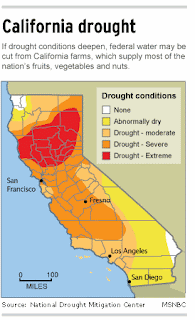California Drought
Drought study refutes criticism of environmental measures
| Thursday, Jun 16 2011 12:05 AM
A
new study pours cold water on claims that environmental protections
worsened the economic impact of California's 2007-09 drought, even as it
highlights significant losses to Kern County farmers as a result of
the crisis.
Released today by Oakland-based think tank The Pacific
Institute, the report finds that less than a quarter of water delivery
cutbacks in 2009 stemmed from environmental restrictions, and that
contrary to industry statements, the Central Valley's agricultural
sector did not suffer disproportionate job losses during the drought.
In fact, it says California farmers enjoyed record sales during the
water shortage.
Even so, the study's authors acknowledge that strong
produce prices lessened the financial harm suffered by farmers during
the drought. The report also credits mitigation efforts -- greater use
of local groundwater, temporary water transfers and fallowing farmland,
among other measures -- that would have been of limited use if the
relatively mild three-year drought had been longer or more severe.
The study also notes that the crisis was felt unevenly across the
valley, with Fresno County seeing a 2 percent increase in agricultural
revenues during the same three drought years that Kern experienced a 9
percent decrease in both revenues and harvested acreage.
Aside from
calling into question some of the blame directed at the Endangered
Species Act during the drought, The Pacific Institute concludes that
California should do more to prepare for the possibility of future
droughts -- not only to help farmers but to safeguard the environment
and reduce the need for more natural gas-fueled power generation when
hydroelectric sources fall short.
Agriculture, energy and the
environment remain "highly vulnerable to future droughts and should
develop more comprehensive drought planning and mitigation measures to
reduce the potential for human, environmental and economic harm," the
report states.
Local damage
Much of the report focuses
on the drought's impact on agriculture in the Central Valley, where
some of the criticism of environmental protections during the drought
originated.
In a section focused on Kern County agriculture, the
study notes that average farming revenues here between 2007 and 2009
exceeded their 2000 levels by 28 percent.
But the report also shows
that Kern citrus growers suffered during the water shortage, noting
that the county's 2009 citrus yield was 37 percent below 2006 levels.
It says Kern's citrus farmers lost more than $150 million between 2008
and 2009.
By comparison, the county's other two top crops -- grapes
and almonds -- weathered the drought relatively well, with Kern's grape
yield falling only 10 percent and the almond yield declined 16 percent
between 2008 and 2009. Strong prices offset some of the decline in
yield.
Farmers react
Dick Minetti, a long-time
agricultural producer who grows oranges, tangerines, grapefruit and
other citrus on a 30-acre ranch in east Bakersfield, said he withstood
the drought fairly well because he had the foresight to install a drip
irrigation system in the 1970s. By depositing water slowly and directly
into the soil, such systems have less evaporation and soil erosion
than traditional above ground sprinkler systems.
"The people who
invested in good conservation systems were in a much better position
during the drought," Minetti said. "Our trees stayed alive. They
probably weren't the best, but they were alive."
It is the future
that growers should be concerned about, said Joe MacIlvaine, president
of Paramount Farming Co., which grows citrus and nuts, among other
fruit.
"We had some good years because we had invested heavily in
banking water supplies in previous years," he said. "But we drew down
our reserves to very low levels, and we're only just now starting to
replenish.
"The impact on the whole southern San Joaquin Valley was
obscured somewhat by our ability to rely on groundwater, but that is
not going to go on indefinitely. Over a period of time, we need to be
able to import a water supply to balance out what we're using."
The
Kern County Water Agency said the report didn't accurately reflect the
reality facing Kern County farms, families and businesses.
"In
fact, the document notes that a California Department of Water
Resources analysis concluded that 25 percent of the state's water supply
impacts are related to regulatory restrictions. This is substantial,"
said agency General Manager Jim Beck.
This year, California's
snowpack peaked at about 173 percent of the April 1 average of snow
water content, yet State Water Project participants have received only
80 percent of the water they need and paid for, Beck said.
"We are
not going to be able to bank as much water as we need to get us through
the next drought, and Kern County farmers will likely have to pay more
than $20 million to buy supplementary water to sustain their
operations," he said.
Beck also contends the report underestimated
the impact on agriculture jobs by focusing exclusively on authorized
workers, even though undocumented workers may account for as much as
half of the agricultural workforce.
"It is unclear how, from this data, valid conclusions can be reached," Beck said.
Multipure Home Drinking Water Filtration Systems
